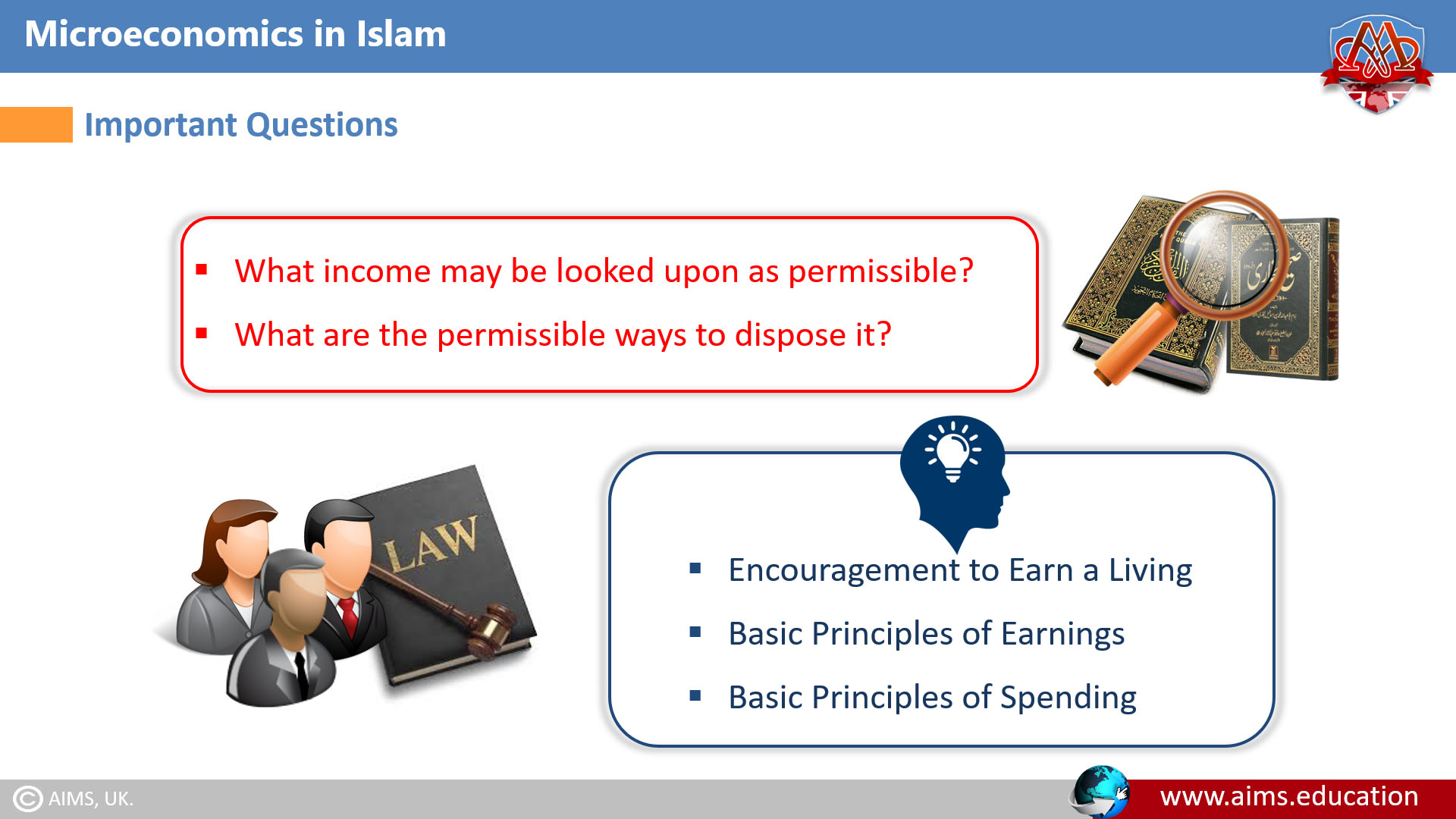Price Theory in Islamic Economics and Finance:
The microeconomic theory deals with the behavior of economic agents of the economic system, like consumers, firms, and factors of production. Islamic economics and finance have their unique approach to the concept of price theory. In traditional Western economic theories, prices are determined by the forces of supply and demand. However, in Islamic economics, there is an emphasis on social justice and avoiding exploitation. This means that under Islamic microeconomics, prices are not solely based on market forces, but also take into consideration the ethical and social implications of pricing. This is reflected in the concept of “just prices” in Islamic finance, where prices are set based on the cost of production and a fair profit margin, rather than solely on what the market will bear.

Microeconomics in Islam – How to Earn and Spend?
According to the Islamic perspective, there are two important questions:
- What income may be looked upon as permissible? and;
- What are the permissible ways to dispose of it?
Islam encourages one to strive for a living according to one’s capacity. According to Islam Shariah, the world is for effort, inertness is death. And Allah has placed many treasures on this earth, but to find them is conditional on us.
Objectives of Islamic Microeconomics
The primary objectives of Islamic Microeconomics are as follows:
1. ECONOMIC WELFARE:
Islamic microeconomics aims to enhance the welfare of society by promoting the equitable distribution of wealth and discouraging the concentration of resources in a few hands.
2. SOCIAL JUSTICE:
It emphasizes the establishment of a just economic system where every individual gets a fair share of resources, and there is no exploitation.
3. SUSTAINABLE DEVELOPMENT:
Islamic microeconomics encourages sustainable use of resources, advocating for a balance between consumption and preservation.
4. MORAL AND ETHICAL CONDUCT:
It fosters a system where economic activities are conducted following ethical guidelines and moral values prescribed by Islamic law (Sharia).
5. HUMAN DIGNITY:
It upholds the dignity and rights of every individual, treating human beings as the most valuable resource.
Balance: It aims to achieve a balance between material needs and spiritual well-being, advocating for a holistic approach to economic development.
Islamic Microeconomics VS. Conventional Microeconomics
Islamic and conventional microeconomics differ fundamentally in their guiding principles, objectives, and the treatment of economic elements. Here are some key differences, that highlight the distinct philosophical and practical approaches between Islamic and conventional microeconomics.
1. INTEREST (Riba):
Islamic microeconomics prohibits the concept of interest (riba), whereas it is a standard practice in conventional economics.
2. RISK AND UNCERTAINTY (Gharar):
Uncertainty and ambiguity are avoided in Islamic microeconomics, as contracts must be clear and certain. Conventional economics, however, accepts a level of risk and uncertainty.
3. SOCIAL RESPONSIBILITY:
While conventional microeconomics primarily focuses on individual profit maximization, Islamic microeconomics places equal emphasis on social responsibility, wealth redistribution, and overall societal welfare.
4. ETHICAL GUIDELINES:
Islamic microeconomics is governed by the moral and ethical guidelines of the Quran and Hadith. In contrast, conventional microeconomics does not incorporate a defined set of ethical rules.
5. PROFIT & LOSS SHARING:
Islamic microeconomics encourages participatory financing models such as Mudarabah (profit and loss sharing agreements) and Musharakah (joint venture), while conventional microeconomics mainly operates on a loan-based system.
6. WEALTH CREATION:
In Islamic microeconomics, wealth must be generated through legitimate trade and investment in the real economy based on Islamic law. Speculative activities (like derivatives and short-selling) are typically discouraged or prohibited. Conventional microeconomics does not impose such restrictions.

Factors of Production in Islam
In Islamic Microeconomics, the factors of production are interpreted with a unique perspective that aligns with the teachings of Islam. These factors are:
1. Labor (Al-Amal):
This refers to the effort, both physical and intellectual, that individuals contribute to the production process. In Islam, labor is highly valued and workers’ rights are strictly protected.
2. Capital (Al-Ra’s al-Mal):
This is the wealth used to generate more wealth. It includes both physical assets, such as machinery and buildings, and intangible assets, such as skills and knowledge. Islam promotes the ethical use of capital and prohibits usury (interest).
3. Land (Al-Ard):
This includes natural resources used in production, such as soil, water, and minerals. Islam encourages the sustainable use of land and resources.
4. Entrepreneurship (Al-Tadbir or Al-Mudarib):
This involves the skills and initiative required to bring the other factors of production together. The entrepreneur takes the risk of investment and is rewarded with profits. In Islamic microeconomics, emphasis is put on ethical business practices and social responsibility.
These factors interact within the Islamic economic framework, which aims for a fair and equitable economy that caters to the needs of society while adhering to the ethical guidelines outlined in the Quran and the Hadith.
Example:
- For example, the concept of riba (interest) is prohibited in Islam, which means that capital cannot be acquired through lending or borrowing money with interest. This encourages alternative financing methods such as profit and loss sharing agreements and asset-backed financing.
- Similarly, the concept of zakat (obligatory charity) places a moral obligation on individuals and businesses to contribute a portion of their wealth towards the welfare of society. This redistributes wealth and ensures the fair distribution of resources among all members of society, ultimately promoting social welfare.
Importance of
Principles of Earning and Spending:
1. Islamic Principles of Earning:
The individual has been bound to certain principles, which save the economy from becoming corrupt. According to Islamic Shariah, humans must keep two principles before them all the time. First, whatever they earn must be permissible. Second, the means used for earning should also be pure and permissible. Following these two laws will keep our spirits and hearts pure, and safe from evil. Moreover, our means should not create Economic difficulties for others, oppression, and cruelty.
2. Islamic Principles of Spending:
Spending is necessary for life’s development. So, it is important to know: What to spend? How much to spend? and On what to spend? Humans spend their money on themselves and others. Islamic microeconomics is based on the complete guidelines given in the Quran and Ahadith.
a. Islamic Principles for Spending on Personal Needs:
The theory of microeconomics in Islam does not allow extravagance spending on useless things, nor miserliness is proper. Islamic microeconomics says that a person should be moderate in spending because it contributes to a better collective economic order.
b. Islamic Principles for Spending on Other’s Needs:
According to Islamic Shariah, the more a person earns, the more he or she is responsible for satisfying others’ needs. The first rights on the individual’s income are those of the family. Besides Zakath other charities and social rights are also incumbent on the individual. In normal circumstances, the “secondary dues” should be paid in such a manner that a reasonable amount is saved for the family, so that they may not be left indigent and begging. However, in special conditions, selfless giving away is commendable.

Scope of Conventional Microeconomics:
Contrary to the scope of microeconomics in Islam, the scope of conventional microeconomics is purely materialistic, as can be seen in the following theories:
1. Price Theory:
Does each conventional economic system have to make decisions regarding What is to be produced? How it is to be produced? and, How resources are to be allocated. All such, under capitalism, is performed with the help of “Price Mechanism”, that is those goods should be produced which maximize profits. Those techniques should be adopted, which minimize the costs of production. And, The resources should be allocated to those uses, where the resources command higher prices; etc. So, we can say that in microeconomics, we deal with the problems of production, consumption, distribution, and resource allocation.
2. Theory of Consumer Behavior and Demand:
Almost everyone faces the problem of multiple wants and limited money. In such a state of affairs, each consumer desires to maximize his satisfaction. And when it happens, the consumer is said to be in equilibrium. Microeconomics also deals with the problems of equilibrium.
3. Theory of Production Behavior:
In conventional microeconomics, four factors of production are responsible for productive activities. According to classical economists in the short run, production depends upon the units of labor only, while the capital is kept fixed. In such a state of affairs, the total production increases at different rates. This phenomenon is known as the “Law of Variable Proportions” in microeconomic theory.
4. Theory of Firm Behavior:
Like individuals, firms also want to attain equilibrium. And equilibrium of the firm is attached to the “Minimization of Costs” or “Maximization of Output”. Both these situations are called “Optimum Factor Combination of a Firm”.
5. Theory of Costs and Revenues:
In conventional microeconomics, we study different types of costs of production. The analysis of costs of production may be from a short-run point of view, as well as from a long-run point of view. Moreover, different types of revenues are also considered in microeconomics.
6. Theory of Market Structure and Behavior:
In conventional microeconomics, markets like Perfect Competition, Monopoly, Duopoly, Oligopoly, and Monopolistic Competition are of greater significance for microeconomics. It is analyzed that firms under different market conditions, make decisions regarding the determination of price and output.
7. Theory of Income Distribution:
The national income of a country is the result of joint efforts of land, labor, capital, and organization. And, national income has to be distributed amongst these factors of production. For Example: How the wages will be determined in competitive and non-competitive markets? For this purpose, we have the classical and neo-classical theories in microeconomics.
8. Theory of General Equilibrium and Welfare Economics:
A general equilibrium is defined as a state in which all markets and all decision-making units are simultaneously in equilibrium. That is, a general equilibrium exists if each market is cleared at a positive price, with each consumer maximizing his satisfaction, and each firm maximizing profit.

Islamic Microeconomics in Practice:
Islamic microeconomics is a fascinating and rapidly growing field that sheds light on the unique economic principles and practices within the Islamic economic system. This dynamic area of study stems from the fundamental teachings of Islam, which emphasize social justice, wealth distribution, and ethical financial transactions. It offers an alternative approach to conventional microeconomics, focusing on the individual’s role in promoting economic growth and prosperity in accordance with Islamic values and principles. Unlike conventional microeconomics, which primarily centers around profit maximization and self-interest, microeconomics in Islam encourages a balance between individual and societal welfare.
Key Characteristics of Microeconomics in Islam:
- At the core of Islamic microeconomics lies fairness and equity in economic transactions.
- Economic growth is achieved through the prohibition of interest (riba), the promotion of risk-sharing, and the establishment of a transparent and accountable financial system.
- It addresses contemporary economic challenges, such as poverty alleviation, income inequality, and sustainable development.
- Through its unique financial instruments like Zakat (a mandatory charitable contribution), Sadaqah (voluntary charity), and Qard Hasan (interest-free loans), Islamic microeconomics promotes a culture of giving and social responsibility.
- Redistribution of wealth fosters a sense of solidarity and cooperation amongst the community members.
- Islamic microeconomics encourages entrepreneurship and innovation through Islamic financial instruments, such as Mudarabah (partnership-based financing) and Musharakah (equity-based financing) arrangements. These modes of funding enable individuals with limited resources to access capital, allowing them to establish and grow their businesses without the burden of debt or interest.
- It allows the economy to grow and creates employment opportunities, ultimately contributing to a more equitable and prosperous society.
Conclusion:
Microeconomics in Islam offers a refreshing and exciting perspective on economic theory and practice. By integrating ethical values and social responsibility into its core principles, it presents a sustainable and equitable alternative to conventional microeconomics. As the world continues to grapple with pressing economic issues, it is essential to explore and embrace diverse approaches, such as Islamic microeconomics, that hold the potential to drive positive change and inclusive growth.
